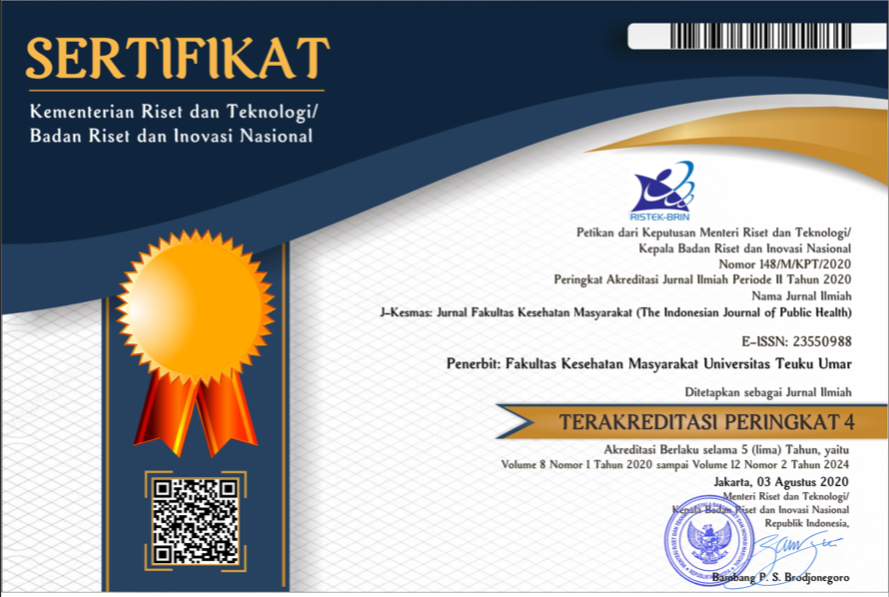The Isolation of Staphylococcus Epidermidis Bacteria in White Snapper Salted Fish (Lates Calcalifer) of Sibolga City, North Sumatera Province
Abstract
Full Text:
PDFReferences
Agustina, D., Yulvizar, C., & Nursanty, R. (2013) Isolation and characterization of bacteria in mackerel Salted fish. Bio Spesies, 6(1):15-19.
Akerina, F.O. (2018) Microbial contamination of smoked tuna in several traditional tobelo markets, North Halmahera, Indonesia. J. Aquaculture, Coastal and Small Islands, 2(1):17-21.
Asao, T., Kumeda, Y., Kawai, T., Shibata, T., Oda, H., Haruki, K., Nakazawa, H., & Kozaki, S. (2003) An extensive of Staphylococcal food poisoning due to low-fat milk in japan: estimation of enterotoxin a in the incriminated milk and powered skim milk. Epidemol Infect. 130: 33-40.
Carter, G.R. (1987) Essentials of veterinary bakteriologi and micology. 3rd ed. Lea and Febriger. Philadelphia.
Chessa, D., Ganau, G., & Mazzarello, V. (2015) An overview of Staphylococcus epidermidis and Staphylococcus aureus with a focus on developing countries. J. Infection in Developing Countries, 9(6): 547-550.
Faridz, R., Hafiluddin, & Anshari, M. (2007) Analysis of the number of bacteria and the presence of Escherichia coli in anchovy processing at PT. Manage marine units in the Sumenep unit. EMBRYO, 4(2): 94-106.
Fifendy, M., Rattriana, F., & Irdawati (2017) Isolation and identification of halophilic gutters (Chorinrmus sp) from Aia Bangih Pasaman Barat, J. BioScience. 1(2): 21-28.
Geffken, R., Hendrik., & Zulkarnain. (2017). Analysis of salted fish processing business in Pondok Batu Village, Sarudik District, Sibolga City, North Sumatra Province. JOM, 4(1): 1-9.
Hayu, R.E. (2018) Staphylococcus Sp. bacterial contamination in extraordinary events of food poisoning in Sawangan Hamlet, Magelang Regency, Central Java, Indonesia. Journal of Public Health Sciences, 7(2):22-32.
Jamaluddin, Suryanto, D., & Lesmana, I. (2016) Types of gram-positive bacterial pathogenic potential in milkfish (Chanos chanos) in the pond of Tanjung Rejo Paluh Putri Percut Sei Tuan village. J. Aquacoastmarine, 4(4): 2-10.
Kamal, S., Nurliana., Jamin, F., Sulasmi., Hamny., & Fakhrurrazi. (2016) Total psychotropic bacteria of tilapia (Oreochromis niloticus) given an increase in temperature at the time of maintenance. Veterinarian Medical J. 10(1) :37-40.
Karimella, E.J., Ijong, F.G., Palawe, J.F.P., dan Mandeno, J.A. (2018) Isolation and identification of Staphylococcus epidermidis bacteria in pinekuhe smoked fish, J. Fisheries and Marine Technol. 9(1) :35-42.
Kateete, D.P., Kimani, C.N., Katabazi, F.A., Okeng, A., Okee, M.S., Nanteza, A., Joloba, M.L., and Najjuka, F.C. (2010) Identification of Staphylococcus aureus: Dnase and manitol salt agar improve the efficiency of the tube coagulase test. Annals of Clinical Microbiol. Antimicrob., 9(23): 1-7.
Marpaung, R. (2015) Microbiological studies on dried salted fish products marketed in traditional markets and supermarkets in an effort to improve food safety in Jambi City. Batanghari University Jambi Scientific J, 15(3): 145-151.
Mulyono, M. (2011) White Snapper Cultivation (Lates calcalifer bloch). Center for Maritime and Fisheries Counseling Development Agency for Maritime and Fisheries Human Resources, Ministry of Maritime Affairs and Fisheries.
Pailu, P.T., dan Budiarso, T.Y. (2017) Isolation and identification of Staphylococcus sp in powdered infant milk. AIP Conference Proceedings, 1844-1908.
Purnomo, I.M.H., Lestari, S.D. dan Baehaki, A. (2017) Analysis of the content of formaldehyde, pesticides, and mushrooms in several types of salted fish. J. Fisheries Product Technol. 6(1): 47-55.
Puspita, E.R., Yanuartono, Hartati, S., Rahardjo, S., Nururrozi, A., dan Indarjulianto, S. (2018) Isolation and identification of Staphylococcus epidermidis in cow's milk PFH patients with subclinical mastitis in Wukirsari, Cangkringan, Sleman DIY. J. Anim. Husbandry, 28(2): 121-128.
Rahayu, N.P.N., Kawuri, R. Dan Suriani, N.L. (2014). Staphylococcus aureus civilization test on traditional sausages (sequence) circulating in the traditional market of Denpasar, Bali. J. Symbiosis, 2(1): 147-157.
Rahmani, Yunianta, & Martati, E. (2007) Effect of wet salting method on the characteristics of cork (Ophiocephalus striatus) salted fish products. J. Agric. Technol., 8(8): 142-152.
Riski, K., Fakhrurrazi., & Abrar, M. (2017). Isolation of Staphylococcus aureus bacteria in salted gutters (Scomberoides commersoniaus) in Leupung District, Aceh Besar Regency. Vet. Student Scientific J. 1(3): 366-374.
Safrida, Y.D., Yulvizar, C., & Devira, C.N. (2012). Isolation and characterization of potentially probiotic bacteria in mackerel (Rastrelliger sp). Depik J., 1(3): 200-203.
Sakti, H., Lestari, S., & Supriadi, A. (2016) Changes in the quality of cork fish (Channa striata) smoke during storage. J. Fisheries Product Technol., 5(1): 11-18.
Salosa, Y.Y. (2013) Test the levels of formaldehyde, salt content and total mackerel salted fish bacteria from the Regency of Papua Province. Depik J., 2(1): 10-15.
Sihite, H.H. (2013) Study of the utilization of fish waste from fish auction sites (TPI) and Nauli Sibolga traditional markets into fish flour as raw material for animal feed. J. Unimal Chemical Technol. 2(2): 43-54.
Sukmawati., & Hardianti, F. (2018) Analysis of microbial total plate count (TPC) in snapper salted fish in Sorong City, West Papua. J. Biodjati, 3(1): 72-78.
Susianawati, R., Sya’rani, L., & Agustini, T.W. (2007) Study of GMP and SSOP application on dried salted fish products in an effort to improve food safety in Kendal Regency. Sea Sand J., 2(2): 40-53.
Tuyu, A., Onibala, H., & Makapedua, D.M. (2014) The old study of salted fish (Selaroides sp) drying was related to water content and organoleptic value. J. Fisheries Product Technol. Media, 2(2): 20-26.
Wardani, R.I. & Mulasari, A. (2016) Identification of formaldehyde in salted fish sold in the coastal area of Turtle Bay in Cilacap Regency. J. Pub. Health, 10(1): 43-48.
DOI: https://doi.org/10.35308/j-kesmas.v7i1.1918
Refbacks
- There are currently no refbacks.
Managed by Fakultas Kesehatan Masyarakat
Published by Universitas Teuku Umar
Website: http://jurnal.utu.ac.id/jkesmas
Email: jkemas@utu.ac.id 
This work is licensed under a Creative Commons Attribution-ShareAlike 4.0 International License.







.jpg)


